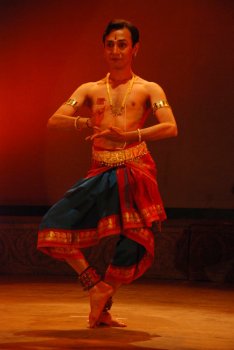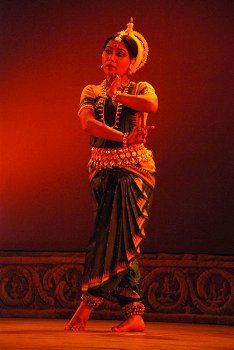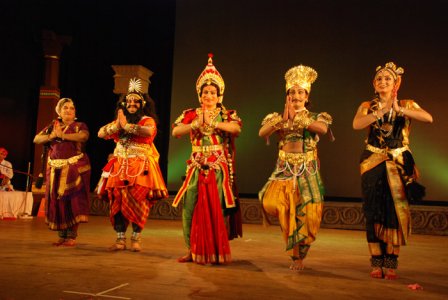
|   |

|   |
Drishti Festival in Bangalore - G Ulaganathan, Bangalore e-mail: ulag_nath@yahoo.com February 11, 2011 The Drishti Dance Festival has become an important event in the cultural calendar of Bangalore every year and this year the sixth edition at the Chowdiah Memorial Hall in Bangalore was a visual treat to the art lovers of the city. Originally scheduled to be held in January first week, the festival was put off in the last minute due to the Bangalore bandh and took place a couple of weeks later on February 7. Dancer Anuradha and her husband Vikranth have been able to put together an impressive team of dancers and performers every year and organize this festival on a grand scale. This year too, three different dance forms were on show. As usual, the event began with an invocation by the students of the dance school - Bhavya B C, Tincy Monappa, Ramya, Aishwarya Tolpady and Archana (disciples of Anuradha Vikranth).  P Praveen Kumar This was followed by Pushpanjali by male dancer P Praveen Kumar, known for his portrayal of Krishna. He also did not disappoint his admirers by presenting a small item Krishnanjali and donned his favourite role as Lord Krishna. The lyrics for this were taken from Krishna shata namavalli stotra. The varnam in Raga Reethigowla was set to tune by Tirumalai Srinivasa Iyengar and was set In Talam aadi.  Anuradha Vikranth Anuradha Vikranth then took over and presented 'Sthree' in Bharatanatyam style. From the mythological times, there have been three types of women who, in dance, are known as Sweeya, Parakeeya and Samanya Nayikas. Sweeya represents a married woman faithful to her husband. Parvathi is an embodiment of a Sweeya woman and her tale was beautifully portrayed by Anuradha. Parvathi is in total love with Lord Shiva when she sees him doing tapas, and wants to win him over with her beauty and creates a very romantic atmosphere with the help of Manmatha. Shiva is very angry and turns Manmatha into ashes. Parvathi realizes that she cannot win Lord Shiva with her external beauty and decides to give away her beauty and do penance. She gives away her smile to the flower, her hair to the snake, her eyes to the deer, her gait to the hamsa and does penance. To test her penance, Lord Shiva disguises himself as an old man and teases her about Shiva. Being strong with her thoughts, Parvathi stops him from talking badly about Shiva only to realize and find that it is none other than Shiva himself. Parakeeya represents a married woman who is in love with another man. Radha, the daughter of Vrishabanu, is the embodiment of love. She is deeply in love with Krishna. She is married but her love for Krishna is seamless. At a point she debates her decision to stay back with her family or go looking for Krishna. The various facets of Radha's personality - Vasaka Sajika (adorning herself for Krishna), Abhisarika (who goes all out looking for Krishna), Virahothkhandita (suffering from the pangs of separation) and Khandita (angry with Krishna) but Krishna wins her over again with his leela and charm, were brilliantly rendered by Anuradha. Samanya represents the quintessential modern woman who belongs to all; the tale of Urvashi and Pururava was used to represent a Samanya Nayika. Urvashi is the most beautiful woman that god ever created. Once when Urvashi is walking amidst the beautiful forest, she is attacked by the demon Keshi. King Pururava saves Urvashi from this demon. Urvashi and Pururava both fall in love with each other and Urvashi agrees to stay back with him on various conditions. One fine day, Urvashi gets angry with Pururava for not abiding by her conditions, and goes back to Ghandarva loka saying that she is woman made for all and cannot be attached to one man only. Script was by Shatavadhani Dr R Ganesh and Praveen Rao scored the music. Apt lighting by the expert in the business Sai Venkatesh, and stage props added value to the well choreographed numbers. Then came the long interlude with felicitations, and fairly long speeches by two bureaucrats which could have been avoided or best scheduled either before or end off the performances.  Aruna Mohanty A short but impressive Odissi performance by Aruna Mohanty followed. She performed 'Pallavi', the pure dance number, and followed it up with Ramate Yamuna Pulina Vane from Gita Govinda where she depicted a jealous Radha imagining Lord Krishna with another girl.  Vijaya Vilasam The last performance was Vijaya Vilasam, a combination of two dance forms - Kuchipudi and Yakshagana. The performance was presented by dancer and guru Veena Murthy and the Samanvay Dance Company and showcased the two dance forms brilliantly. Though these forms are from different lands they have interesting similarities as well as parallels. This Yakshagana is an attempt to look into two dance forms in all their splendor. Be it the dance, the costumes, the music, there are similarities and dissimilarities which are clearly visible. The Yakshagana was presented in 3 episodes involving the great warrior Arjuna on his thirtha yatra. On his way, he is attracted to Ullupi, the princess of Nagaloka, and then he is enticed by Chitrangada and Subadra. Veena presented some of the veterans like Mantap Prabhakar Upadhya, who has made exceptional contribution to the field of Yakshagana, Vedantam Venkatachalapathi Rao from Kuchipudi, young and pretty dancer from Bangalore Shama Krishna and Krishna Murthy Thunga. On this occasion, the Drishti Nrityakala Puraskar 2011 was conferred on Asha Gopal, the Director of Arathi School of Dance, USA and Aruna Mohanty. In the absence of any major dance festivals, Bangaloreans have been looking forward to the Drishti Festival every year and what is unique about this festival is that Anuradha offers a platform for not only top classical dancers, but also to traditional folk artistes. It is also an occasion for her students to exhibit their talents and hopefully the festival would also include a workshop and an interactive session during the day. Ulaganathan is a Bangalore based writer and dance critic. |